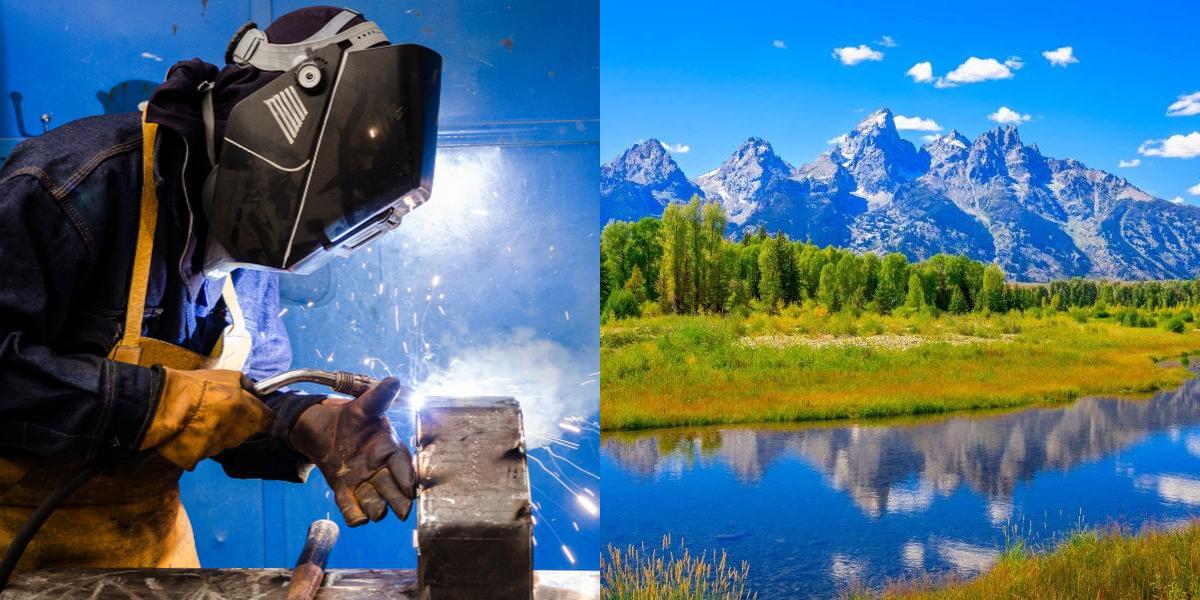How to Become a Welder in Wyoming

Welding is a skilled trade that involves joining metal pieces together using various techniques such as heat, pressure, or both. Welders play a crucial role in construction, manufacturing, and repair industries. If you are interested in pursuing a career as a welder in Wyoming, here's what you need to know:
How do I get my Welder certification?
If you're interested in becoming a welder, getting certified is an important step in your career journey. Certification not only demonstrates your knowledge and skills in the field but also increases your job prospects and earning potential. In this section, we will discuss the steps to obtaining your welder certification.
-
Research certification requirements: Before you start the certification process, it's important to research the specific requirements for the type of certification you're interested in. Different welding processes (such as MIG, TIG, or stick welding) may have different certification standards. Additionally, certain industries or employers may have specific certifications they require.
-
Enroll in a welding program: To gain the necessary skills and knowledge to become a certified welder, it's recommended to enroll in a welding program. These programs are often offered at community colleges, vocational schools, or trade schools. Look for programs that are accredited by welding organizations such as the American Welding Society (AWS) or the Welding Technology Institute of Australia (WTIA). These programs typically offer hands-on training and cover topics such as welding techniques, safety procedures, and blueprint reading.
-
Gain practical experience: While completing a welding program is a great way to learn the theoretical aspects of welding, gaining practical experience is equally important. Many welding programs include hands-on training, but it's also beneficial to seek out additional opportunities to practice your skills. Consider participating in internships, apprenticeships, or volunteer work to gain real-world experience under the guidance of experienced welders.
-
Prepare for the certification exam: Once you feel confident in your welding skills and knowledge, it's time to start preparing for the certification exam. The AWS offers several different types of welding certifications, including Certified Welder (CW) and Certified Welding Inspector (CWI). These exams typically consist of a combination of written and practical tests. Study the exam guidelines and practice the required welding techniques to ensure you're well-prepared.
-
Take the certification exam: After adequate preparation, it's time to take the certification exam. The exam may be administered by an accredited institution or an AWS-approved testing facility. Be sure to bring any necessary documentation, such as identification and proof of completion of a welding program. During the exam, demonstrate your skills and knowledge by following the provided instructions and completing the required welding tasks.
-
Maintain your certification: Once you've successfully passed the certification exam, it's important to maintain your certification by staying updated on the latest welding techniques and safety procedures. Many certifications require periodic renewal, which may involve continuing education courses or retesting. Stay connected with professional organizations such as the AWS to access resources, networking opportunities, and updates in the field.
How do I get a job as a Welder?
Now that you have obtained your welder certification, you may be wondering how to secure a job in the field. The demand for skilled welders is high, and there are several steps you can take to increase your chances of finding employment as a welder.
-
Build a strong resume: A well-crafted resume is essential when applying for welding jobs. Highlight your welding certification, relevant education, and any practical experience you have gained. Include details about the specific welding techniques you are proficient in and any specialized training you have completed. Additionally, emphasize any transferable skills such as attention to detail, problem-solving abilities, and teamwork.
-
Create a portfolio: Along with your resume, consider creating a portfolio of your welding work. Include photographs or samples of projects you have worked on, showcasing your skills and the quality of your work. This can be particularly beneficial for welders who have limited work experience or are entering the field as freelancers.
-
Network: Networking is important in any industry, and welding is no exception. Attend industry events, trade shows, and job fairs to connect with potential employers and other professionals in the field. Joining professional organizations such as the AWS can also provide networking opportunities and access to job boards or career resources.
-
Utilize online platforms: In today's digital age, online platforms can be a valuable tool for finding welding jobs. Create profiles on professional networking sites such as LinkedIn, and join welding-specific groups or forums. Many job search websites also have dedicated sections for skilled trades, including welding. Utilize these platforms to search for job openings and connect with hiring managers or recruiters.
-
Apply to welding companies: Research and identify welding companies in your area or industries that require welders. Many companies have their own job boards or accept online applications. Tailor your resume and cover letter to each specific company, highlighting how your skills align with their needs. Consider reaching out directly to hiring managers or supervisors to express your interest and inquire about any open positions.
-
Consider apprenticeships or entry-level positions: If you're new to the field or have limited experience, consider applying for apprenticeships or entry-level positions. These opportunities can provide valuable on-the-job training and the chance to gain experience in a professional welding environment. While the starting pay may be lower, it can be a stepping stone to more advanced positions in the future.
-
Be prepared for interviews: As you start receiving interview invitations, it's important to be well-prepared. Research the company and the specific role you're applying for, and come up with thoughtful questions to ask during the interview. Practice common interview questions and prepare examples of how your skills and experience align with the job requirements. Dress professionally and bring copies of your resume and portfolio to leave with the interviewers.
-
Continue learning and improving: Even after securing a job as a welder, it's important to continue learning and improving your skills. The field of welding is constantly evolving, and staying updated on new techniques and technologies can help you remain competitive in the job market. Seek out opportunities for professional development, such as attending workshops or pursuing advanced certifications.
Career Paths and Opportunities after Becoming a Welder
Becoming a certified welder opens up a variety of career paths and opportunities. Welders are in high demand across industries such as construction, manufacturing, automotive, aerospace, and shipbuilding. Here are some potential career paths you can explore after becoming a welder:
-
Welding technician: As a welding technician, you will work closely with engineers and designers to fabricate and assemble metal structures or components. This role requires a strong understanding of welding techniques and the ability to read blueprints and technical drawings.
-
Pipe welder: Pipe welders specialize in welding pipes and other cylindrical structures. They work in industries such as oil and gas, plumbing, and construction. Pipe welding requires specialized skills and knowledge of pipefitting techniques.
-
Underwater welder: Underwater welding combines welding skills with diving expertise. Underwater welders work on offshore structures, ships, and underwater pipelines. This career path requires additional training and certifications in commercial diving.
-
Welding inspector: If you have a keen eye for detail and a strong understanding of welding standards and codes, a career as a welding inspector may be a good fit. Welding inspectors ensure that welding processes and procedures meet industry standards and specifications.
-
Welding instructor: If you enjoy teaching and sharing your knowledge, becoming a welding instructor can be a rewarding career choice. Welding instructors work in vocational schools or training centers, imparting their welding skills and knowledge to aspiring welders.
-
Freelance welder: As a certified welder, you have the option to work as a freelancer or start your own welding business. This allows you to have more control over your work schedule and choose the projects you want to work on.
How much does a Welder make?
The average salary for a welder can vary depending on factors such as experience, location, and industry. According to the U.S. Bureau of Labor Statistics (BLS), the median annual wage for welders, cutters, solderers, and brazers was $43,410 as of May 2020. The lowest 10 percent earned less than $30,860, while the highest 10 percent earned more than $64,240.
Starting salaries for welders can vary greatly. Entry-level welders with little to no experience may start at or near the lower end of the salary range. However, as they gain experience and develop their skills, their earning potential increases.
Final Thoughts
Becoming a certified welder can open up a world of opportunities and provide a rewarding career in a high-demand field. By following the steps outlined in this article, you can obtain your welder certification, secure a job as a welder, and explore various career paths within the welding industry. Remember to continue learning and improving your skills to stay competitive and advance in your welding career.
If you're considering a career shift or curious about different professional paths, Dreambound has written many guides to help you in making informed decisions. Here are a few:

Harold Roldan is a Growth team member at Dreambound. With a background in IT, he works with data and automation to improve team efficiency and workflows. He spends his free time playing musical instruments or studying data, computers, and technology.




